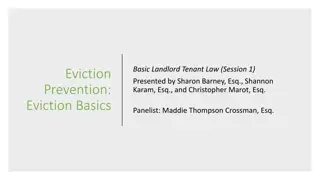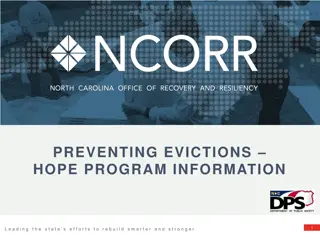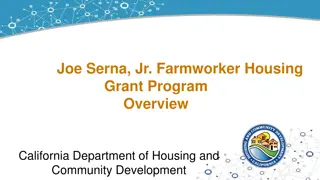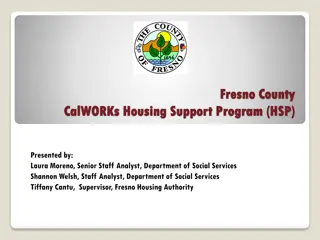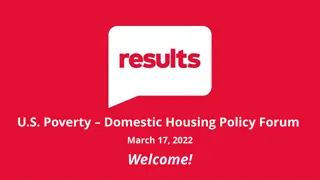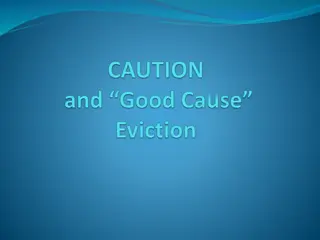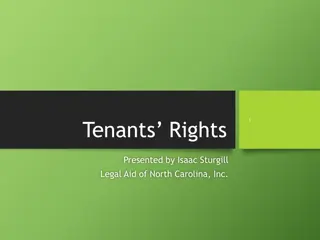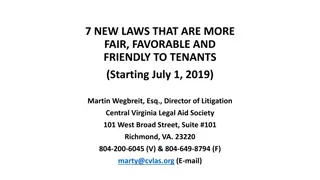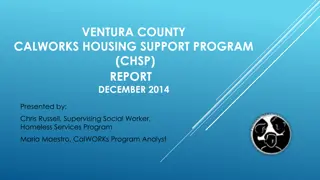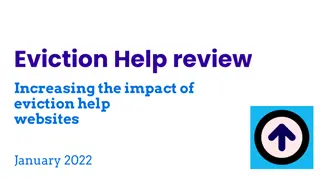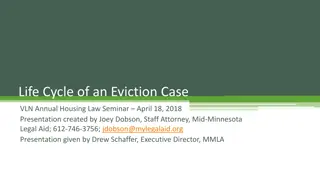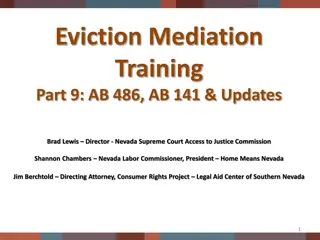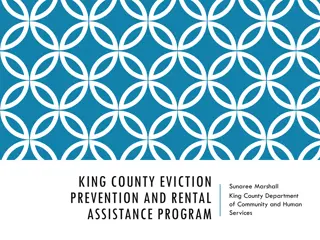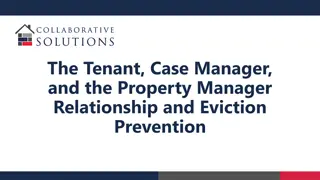Housing Opportunities and Prevention of Eviction (HOPE) Program Information
The HOPE Program is a vital initiative addressing renter needs due to the pandemic, offering streamlined assistance in 88 counties to provide housing stability. Funded by the U.S. Treasury, it assists eligible applicants with rent and utility payments, with a focus on vulnerable renters. Applicants can apply online or contact the dedicated center for aid.
Download Presentation

Please find below an Image/Link to download the presentation.
The content on the website is provided AS IS for your information and personal use only. It may not be sold, licensed, or shared on other websites without obtaining consent from the author.If you encounter any issues during the download, it is possible that the publisher has removed the file from their server.
You are allowed to download the files provided on this website for personal or commercial use, subject to the condition that they are used lawfully. All files are the property of their respective owners.
The content on the website is provided AS IS for your information and personal use only. It may not be sold, licensed, or shared on other websites without obtaining consent from the author.
E N D
Presentation Transcript
PREVENTING EVICTIONS HOPE PROGRAM INFORMATION 1 L e a d i n g t h e s t a t e s e f f o r t s t o r e b u i l d s m a r t e r a n d s t r o n g e r .
THE HOPE PROGRAM The Housing Opportunities and Prevention of Eviction (HOPE) Program is part of a statewide effort to address renter needs due to the coronavirus, offering assistance in 88 non-metropolitan counties. The objective of the program is simple to provide housing stability to vulnerable renters. The program is designed to be as streamlined as possible to allow for fast application and quick payment of funds to landlords and utility providers. At this point, HOPE is able to pay rent and utilities within 14 days of application. 2
HOPE ACCOMPLISHMENTS TO DATE Last year, the first version of the HOPE Program assisted 37,000 households with $133 million in rent and utility payments. This year, the second version of the HOPE Program has helped 25,000 applicants so far with more than $65 million awarded in the last 6 weeks. The program is accepting applications NOW. 3
HOPE PROGRAM BASICS The HOPE Program is funded by the U.S. Treasury Department s Emergency Rental Assistance Program. Approximately $800 million is available for the HOPE Program for a statewide rent and utility assistance program. The HOPE Program is operating in 88 counties. The remaining 12 counties (the largest counties in the state) are running their own eviction prevention programs. You can reach those individual programs from the HOPE website. 4
HOPE PROGRAM ELIGIBILITY Applicants must: Earn an income less than or equal to 80% area median income based on their county of residence; - Occupy a rental property as their primary residence and be a named party to the lease or rental agreement; - Experience difficulty paying rent due to coronavirus pandemic related impacts. - Specific eligibility criteria is asked in the application. 5
METHOD OF DELIVERY Applicants can apply using an online application at www.hope.nc.gov. Applicants may also contact the dedicated contact center at 1(888) 9-ASK-HOPE. Applications opened in May 2021 and will close when the funds are expended. If a person received HOPE assistance last year, they were contacted by email to re-apply. 6
AREAS NOT SERVED BY HOPE County Buncombe Cabarrus Cumberland Mecklenburg Durham Forsyth Gaston County Guilford Johnston New Hanover Union Wake Five tribal organizations also received the Haliwa-Saponi Indian Tribe, - their own allocation of funds: the Lumbee Tribe of North Carolina, - Eastern Band of Cherokee Indians, and - the Coharie Tribe, the Waccamaw-Siouan Tribe. - - 7
HOPE RENT ASSISTANCE Provides up to 12 months of rent assistance. This includes up to 9 months of arrears total. Previous HOPE assistance received counts as a payment for arrears. - Assistance is provided for any arrears (up to 9 total months of arrears) plus 3 months of future rent assistance at a time. Applicants will reapply for assistance as needed, funds permitting. - Assistance is paid directly to the landlord on behalf of the applicant. 8
WHAT DOES RENT ASSISTANCE COVER? Arrears on behalf of the applicant, up to 9 months total. Future recurring rent payments, up to 3 months at a time. Existing fees or surcharges that are part of the rent agreement, such as pet fees, insurance fees, utility fees, or other fees if they were pre-existing. Covering security deposits that have been applied to back owed rent. 9
WHAT DOES RENT ASSISTANCE NOT COVER? Late fees or penalties assessed by the landlord. Legal fees associated with eviction or other disputes. Costs incurred by subletters or other individuals that are not part of a lease agreement. Costs of alleged damage, including property damage, damage to credit, or other monetary or physical damage by either party. Lease drafting, administrative, or accounting fees. Equipment storage fees or leases. Commercial, agricultural, or other non-residential leases. Payments owed by permanent residents of hotels or motels. Leases where the applicant is not the primary resident. Arrears prior to April 1, 2020 or not related to coronavirus. 10
HOPE RENT AWARD CALCULATION The HOPE Program pays the rent the applicant owes up to a cap equal to the 2 bedroom unit fair market rent (FMR) cap for that county. If the applicant pays MORE than the 2-bd FMR, the award is capped at the FMR. If an applicant resides in subsidized housing, such as Public Housing, the HOPE Program pays for the amount of rent that the applicant pays to the PHA. 11
HOPE DOCUMENTATION REQUIREMENTS A lease agreement is required to be uploaded when the applicant applies for assistance. The lease agreement must have the tenant names, rental address, and the amount owed a month at a minimum. In the absence of a lease, a written statement (lease summary) from the landlord is acceptable. Includes the tenant name(s), the rent address, the amount owed per month, how many months late the tenant is, and when the lease ends. - NCORR has developed a template for this for landlords and applicants to use. - Proof of payment of previous month s rent to the landlord is also acceptable. - 12
WHAT THE LANDLORD AGREES TO Landlord agrees that they shall not evict for non-payment within 60 days of the last month of assistance covered by the Program. Landlord agrees to dismiss summary ejection proceedings (eviction). Landlord agrees to work with tenant to form a payment plan, if necessary, for any rent not covered by HOPE Program rent assistance. Confirms the landlord has not received payment for the rent amount due from any other source. 13
WHAT THE LANDLORD AGREES TO Landlord must maintain a safe and habitable dwelling. Landlord must not increase rent or fees for the duration of the lease. Landlord must pay any utilities owed if that is a part of the lease and the Program agreement. The landlord and tenant jointly agree to the terms of the agreement and it is returned to the Program by both parties. 14
HOPE UTILITY ASSISTANCE The HOPE Program also provides emergency utility assistance. Assistance is paid directly to the utility provider on behalf of the applicant. Assistance pays for back-owed utilities only. Covers critical utilities. 15
WHAT DOES UTILITY ASSISTANCE COVER? Natural gas/propane delivery for home use/heating This includes routine safety checks if that is part of the delivery. - Electricity Water Sewer and Wastewater 16
UTILITY ASSISTANCE AWARD LIMIT The applicant reports the amount they owe to the utility provider in the application. The award is for the lesser of that reported amount or the cap shown below. The program may eventually pay up to 12 total months of assistance in this way Previous HOPE awards made for the utility count towards the 12 month limit. - Utility Electricity Gas Water Wastewater NTE Award Amount $510 $135 $105 $120 17
UTILITY AWARD VERIFICATION The applicant will certify to the award in the application. Once the utility award is paid, the applicant receives a notice of payment. The utility provider is notified that by accepting the award, they agree to certain program requirements. This will be called the Utility Provider Terms and Conditions (UTC). - 18
UTILITY TERMS AND CONDITIONS Apply the amount of the payment to utility account found at the applicant s rental address. Implement a process for overpayments, where; Overpayments are credited to the applicant s account or provided as a refund to the - applicant. Implement a period of time to apply the payment to the applicant s account or cancel the check. Report on the use of funds as needed from NCORR. 19
KEY TIMEFRAMES RENT AND UTILITIES The applicant and the landlord have 21 days to sign agreements before the document expires. This 21 day period also applies to non-responsive applicants if you are requesting documentation or information from the applicant. 20
QUESTIONS 21 L e a d i n g t h e s t a t e s e f f o r t s t o r e b u i l d s m a r t e r a n d s t r o n g e r .


